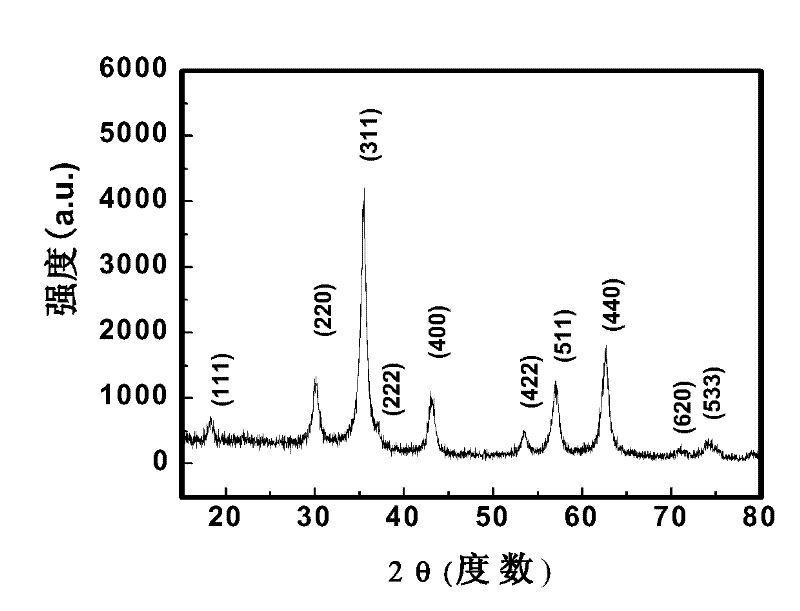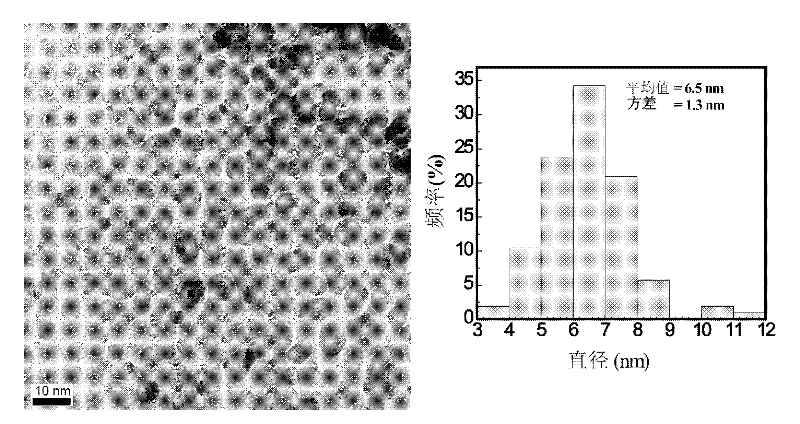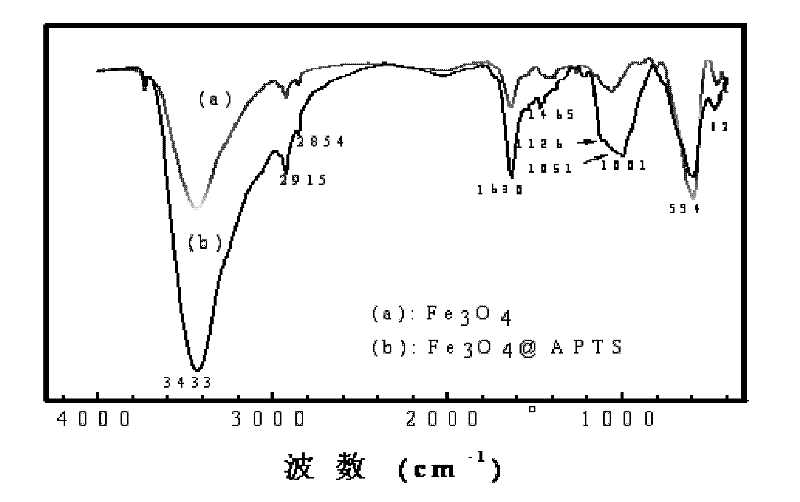Preparation method of APTS (aminopropyltriethoxysilane)-modified iron oxide magnetic nanoparticles
A magnetic nanoparticle, nanoparticle technology, applied in ferrous oxide, iron oxide/iron hydroxide, nanotechnology, etc.
- Summary
- Abstract
- Description
- Claims
- Application Information
AI Technical Summary
Problems solved by technology
Method used
Image
Examples
Embodiment 1
[0047] (1) 1.25g FeCl 2 4H 2 O was sonicated with 7.5 mL of ultrapure water, and then 6.5 mL of NH 3 ·H 2 O was stirred in air for 10 min, then 2.5 mL of 3-aminopropyltriethoxysilane (APTS) was added, and reacted in an autoclave at 134 ° C for 3 hours;
[0048] (2) After the reaction finishes, cool down to room temperature naturally, and the obtained black precipitate Fe 3 o 4 / APTS is dispersed in ethanol or ultrapure water, magnetically separated, redispersed, and magnetically separated, and washed twice with ethanol and five times with pure water to remove excess reagents and redispersed in the water phase.
[0049] TEM test results showed that Fe 3 o 4 The morphology, size and size distribution of / APTS nanoparticles were calculated by Fe 3 o 4 / APTS has a particle size of 6.5nm and no Fe was found3 o 4 / APTS nanoparticles aggregation, indicating that APTS is uniformly modified on the Fe 3 o 4 on the surface of nanoparticles.
Embodiment 2
[0051] (1) 2g FeCl 2 4H 2 O was sonicated with 12 mL of ultrapure water, and then 10 mL of NH 3 ·H 2 O was stirred in air for 10 min, then added 4 mL of 3-aminopropyltriethoxysilane (APTS), and reacted in an autoclave at 140° C. for 5 hours;
[0052] (2) After the reaction finishes, cool down to room temperature naturally, and the obtained black precipitate Fe 3 o 4 / APTS is dispersed in ethanol or ultra-pure water, magnetically separated, re-dispersed, and magnetically separated, and washed twice with ethanol and five times with pure water to remove excess reagents and re-dispersed in the water phase.
[0053] TEM test results showed that Fe 3 o 4 The morphology, size and size distribution of / APTS nanoparticles were calculated by Fe 3 o 4 The particle size of / APTS is 6.7nm, and Fe is not found 3 o 4 / APTS nanoparticles aggregation, indicating that APTS is uniformly modified on the Fe 3 o 4 on the surface of nanoparticles.
Embodiment 3
[0055] (1) The Fe prepared by one-step method 3 o 4 / APTS nanoparticles were dispersed in 10mL of ultrapure water, mixed well with 9.8μL of triethylamine solution, then added dropwise to 1mL of methanol solution containing 7.2mg of acetic anhydride, reacted for 24 hours under strong magnetic stirring, and the surface charge was obtained. Sexual Fe 3 o 4 / APTS.Ac nanoparticles;
[0056] (4) Fe prepared in step (2) 3 o 4 / APTS nanoparticles were dispersed in 5 mL DMSO, and 5 mL of DMSO solution containing 10 mg succinic anhydride (-SAH / -NH 2 molar ratio=5:1), reacted for 24 hours under strong magnetic stirring, centrifuged and washed four times, and the surface was negatively charged Fe 3 o 4 / APTS.SAH nanoparticles;
[0057] Zeta surface potential measurements showed that after acetylation and carboxylation reactions, Fe 3 o 4 / APTS.Ac and Fe 3 o 4 / APTS.SAH surface potential from the initial Fe 3 o 4 The +26.7mV of / APTS dropped to -3.2mV and -25.6mV, respectivel...
PUM
| Property | Measurement | Unit |
|---|---|---|
| size | aaaaa | aaaaa |
| particle diameter | aaaaa | aaaaa |
| diameter | aaaaa | aaaaa |
Abstract
Description
Claims
Application Information
 Login to View More
Login to View More - R&D
- Intellectual Property
- Life Sciences
- Materials
- Tech Scout
- Unparalleled Data Quality
- Higher Quality Content
- 60% Fewer Hallucinations
Browse by: Latest US Patents, China's latest patents, Technical Efficacy Thesaurus, Application Domain, Technology Topic, Popular Technical Reports.
© 2025 PatSnap. All rights reserved.Legal|Privacy policy|Modern Slavery Act Transparency Statement|Sitemap|About US| Contact US: help@patsnap.com



